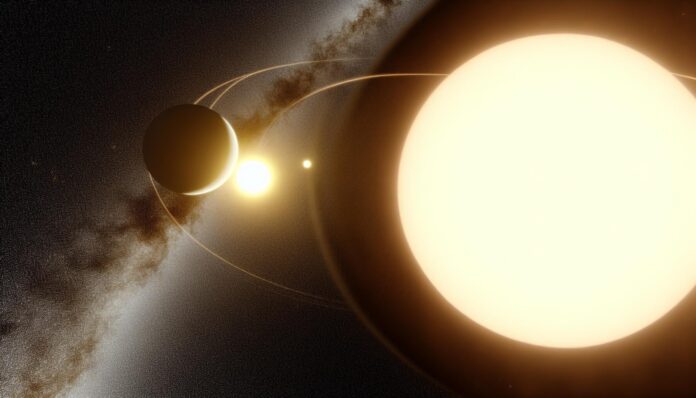New Exoplanet Discovery Challenges How We Understand Planetary Formation
This breakthrough discovery in a double star system is revolutionizing our understanding of planet formation. Astronomers have observed an exceptional case where the two stars in the system are evolving at distinctly different paces. Most importantly, the formation of a giant exoplanet around one star while its companion still showcases active disk materials invites new scientific inquiry.
Because this system was scrutinized using years of observations and state-of-the-art imaging, it provides compelling evidence that challenges the synchronous evolution model. With imagery captured by advanced instruments and data from facilities like the European Southern Observatory, the claim that one star has matured faster than the other now stands on strong empirical grounds. Furthermore, detailed reports such as those published by NASA Science and Universe Today underline the significance of this discovery in broadening our horizons about extrasolar phenomena.
The Out-of-Sync Binary Star System
Typically, binary star systems exhibit a coordinated pace in disk dissipation and planet formation, which has long been assumed in standard astrophysical theories. However, in this unique system, the primary star has already expelled its protoplanetary disk, indicating its phase of active planet formation is complete. In contrast, the secondary star continues to harbor a thick, active disk filled with dust and gas. This divergence is startling because it proves that the evolution of binary systems can occur in a non-uniform manner.
Besides that, additional observations reveal features such as a central cavity and spiral arms around the secondary star that may be linked to the gravitational influence of forming planets. Therefore, these dynamic processes highlight a more complex interplay between stellar components, as further discussed in articles like those on ScienceAlert and Leiden University News. Transitioning to a fresh perspective, astronomers are now questioning whether traditional models need revision to account for such asynchronous development.
Direct Imaging: Spotting a Giant Planet
Observational techniques continue to evolve, and direct imaging remains one of the most captivating methods for exoplanet discovery. Because the primary star’s environment is largely free of obscuring dust, it served as an excellent target for imaging studies. Using the Very Large Telescope’s SPHERE instrument, researchers successfully captured a clear image of a giant planet orbiting the primary star, designated HD 135344 A.
Moreover, the remarkable success of four years of dedicated observations underscores the potential of direct imaging in circumnavigating the brightness issue that often masks planetary light. Most importantly, this method confirms that even in complex systems, the differences in dust composition and disk evolution can be isolated and studied in detail. Consequently, these findings encourage the use of similar techniques in other challenging environments, as noted by the extensive work covered on Phys.org.
Why Is This Discovery So Important?
This discovery holds far-reaching implications for planetary science. Previously, the shared environment of binary stars was believed to enforce a synchronized timeline in planet formation. However, the evidence of asynchronous evolution, where one star is fully matured and its companion is still forming, redefines these assumptions. Because the stars in this system do not influence each other as strongly as once thought, the underlying processes of planetary formation might be more dependent on individual stellar characteristics than binary dynamics.
Therefore, the observed differences in disk composition, mass, and local conditions provide a fertile ground for future theories and models. As researchers delve deeper into binary systems, they will also examine how these discrepancies in evolution may affect planetary stability and the potential for life-supporting conditions. Besides that, new insights from this discovery may lead to a broader reassessment of how common asynchronous planet formation is, influencing both theoretical research and observational strategies.
The Search for Asynchronous Planetary Systems Continues
The ongoing search for additional asynchronous planetary systems is marked by technological advances and refined imaging processes. Astronomers are now employing multi-wavelength observations and high-precision instruments to peer through dusty disks and unveil hidden exoplanets. Because each discovery contributes incremental knowledge, the study of asynchronous systems is quickly reshaping our understanding of multi-star interference in planet formation.
In addition, the quest to uncover more cases of out-of-sync binary stars not only expands our catalog of known exoplanets but also enhances our predictive models of planet formation. Most importantly, these studies help us appreciate the vast diversity in stellar evolution patterns. Therefore, continued exploration using resources like the European Southern Observatory and updated astronomical surveys weaves a richer tapestry of cosmic understanding, as evidenced by ongoing coverage in scientific outlets such as Universe Today.
References
- NASA Science: Discovery Alert – A Possible Perpendicular Planet
- Universe Today: Binary Stars Out of Sync
- ScienceAlert:
- Phys.org: Rare Exoplanet Orbits Twin Stars in ‘Star Wars’-Like Twist
- Leiden University News: Binary Star Reveals Planet Formation Doesn’t Always Happen In Sync



